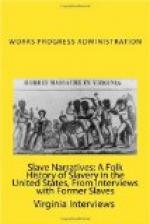“The reason I can’t tell you no more is, since I got old my mind goes this and that a way.
“But I can tell you all the doctors that doctored on me. They give me up to die once. I had the chills from the first of one January to the next We had Dr. Chester and Dr. McCray and Dr. Lewis—his name was Perry—and Dr. Green and Dr. Smead. Took quinine till I couldn’t hear, and finally Dr. Green said, ‘We’ll just quit givin’ her medicine, looks like she’s goin’ to die anyway.’ And then Dr. Lewis fed me for three weeks steady on okra soup cooked with chicken. Just give me the broth. Then I commenced gettin’ better and here I am.
“But I can’t work like I used to. When I was young I could work right along with the men but I can’t do it now. I wish I could ’cause they’s a heap a things I’d like that my chillun and grandchillun can’t get for me.
“Well, good-bye, come back again sometime.”
Interviewer: Samuel S. Taylor
Person interviewed: Campbell Armstrong
802
Schiller Street, Little Rock, Arkansas
Age: 86
[HW: Boys liked corn shuckings]
“I couldn’t tell you when I was born. I was born a good while before freedom. I was a boy about ten years old in the time of the Civil War. That would make me about eighty-five or six years old.
“My father’s name was Cy Armstrong. My mother’s name was Gracie Armstrong. I don’t know the names of my grandparents. They was gone when I got here. My sister died right there in the corner of the next room.
House and Furniture
“I used to live in an old log house. Take dirt and dob the cracks. The floors were these here planks. We had two windows and one door. That was in Georgia, in Houston County, on old Dempsey Brown’s place. I know him—know who dug his grave.
“They had beds nailed up to the side of the house. People had a terrible time you know. White folks had it all. When I come along they had it and they had it ever since I been here. You didn’t have no chance like folks have nowadays. Just made benches and stools to sit on. Made tables out of planks. I never saw any cupboards and things like that. Them things wasn’t thought about then. The house was like a stable then. But them log houses was better than these ’cause the wind couldn’t get through them.
Work as a Boy
“I wasn’t doin’ nothin’ but totin’ water. I toted water for a whole year when I was a boy about eight years old. I was the water boy for the field hands. Later I worked out in the fields myself. They would make me sit on my mammy’s row to help keep her up.
Free Negroes
“You better not say you were free them days. If you did, they’d tell you to get out of there. You better not stop on this side of the Mason Dixie Line either. You better stop on the other side. Whenever a nigger got so he couldn’t mind, they’d take him down and whip him. They’d whip the free niggers just the same as they did the slaves.




